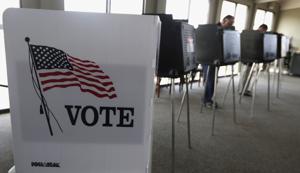(The Center Square) – Election integrity groups have sent a letter to the Illinois State Board of Elections demanding that the state clean the voter rolls of inactive voters within 90 days.
Judicial Watch, Illinois Family Action and an Illinois resident say the state must clear the rolls of inactive voters who have remained on the rolls in violation of the National Voter Registration Act.
Judicial Watch estimates there may be as many as 800,000 inactive voters who should be removed. This is about 10% of the about 8.1 million registered voters in Illinois.
Illinois resident and Illinois Conservative Union Chairman Carol Davis said it’s not a question of whether or not Illinois will comply. The question is “will we have to follow up our letter with a federal lawsuit?”
“This is a federal matter and the NVRA is a federal law that the states must comply with. It is not an option of whether or not they have to remove those inactive voters. It is a law they must obey,” said Davis.
The process dictated in the NVRA, according to Davis, is quite lengthy and complex.
“If someone is not voting, the local election authority has to send a postcard and probe to see if the voter is still at that address,” said Davis. “If that postcard isn’t returned then the local election authority has to send another postcard.”
Davis said authorities have to check and make sure that voter has not voted in the last two federal election cycles. If they have not voted in those elections, they should be moved to an “inactive” status.
“The problem with being inactive, it’s far too easy for a voter to pop back up and say, ‘I know I have been inactive for 10 years but now all of a sudden I am going to vote again.’ We can’t verify that person is actually that person,” said Davis. “It’s too easy for people who want to commit election fraud to get the list of voters and see who’s been inactive for 6-10 years and order a vote-by-mail ballot in that person’s name.”
Federal law directs the Election Assistance Commission to submit a report to Congress every second year assessing how states are complying with the NVRA. Federal regulations require states to provide data to the EAC for use in this report. On June 29, 2023, the EAC posted data from the most recent surveys it sent to the states and Washington, D.C. for the reporting period from November 2020 through November 2022.
After the data from the survey was released, Judicial Watch contacted a number of states, like Illinois and Washington, D.C., to inquire about their compliance with federal law and to request public records.
After processing the responses to these communications, Judicial Watch sent notice of violation letters to Washington, D.C., California and Illinois, detailing their alleged non-compliance with the NVRA.
In Illinois’ responses to the EAC’s survey, 23 Illinois counties reported removing fewer than 15 voters and, in almost half of those counties, zero voter registrations from November 2020 to November 2022 for failing to respond to an address confirmation notice and failing to vote in two consecutive general federal elections.
Thirty-four Illinois jurisdictions simply did not report any data about such removals. Fifteen Illinois jurisdictions have more voter registrations than citizens of voting age.
In total, 57 Illinois counties either reported removing 15 or fewer registrations or failed to report any data at all under the NVRA’s change of address removal procedures.
“It looks like some of them are shrugging it off, or possibly not removing inactive voters when they should,” said Davis. “It’s one thing to set an inactive voter to the side, but there is a point where those voters cannot just sit there forever.”
Davis said she hopes the Illinois State Board of Elections will remove at least half of the 800,000 inactive voters, and that the removal will make a big difference in some elections.
“The nefarious people will be trying to pile more voters on those rolls just as we are taking them off,” said Davis. “Precinct committeemen should be watching precinct lists and making sure they’re not piling suspicious voters on. This is not a one and done, but it is a huge leap forward for election integrity.”



















